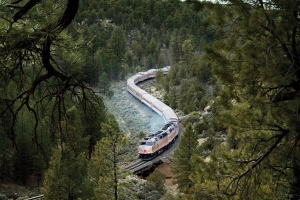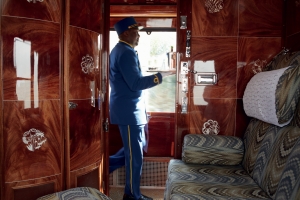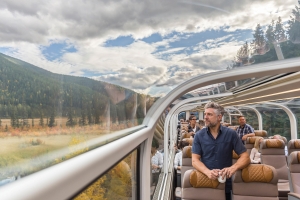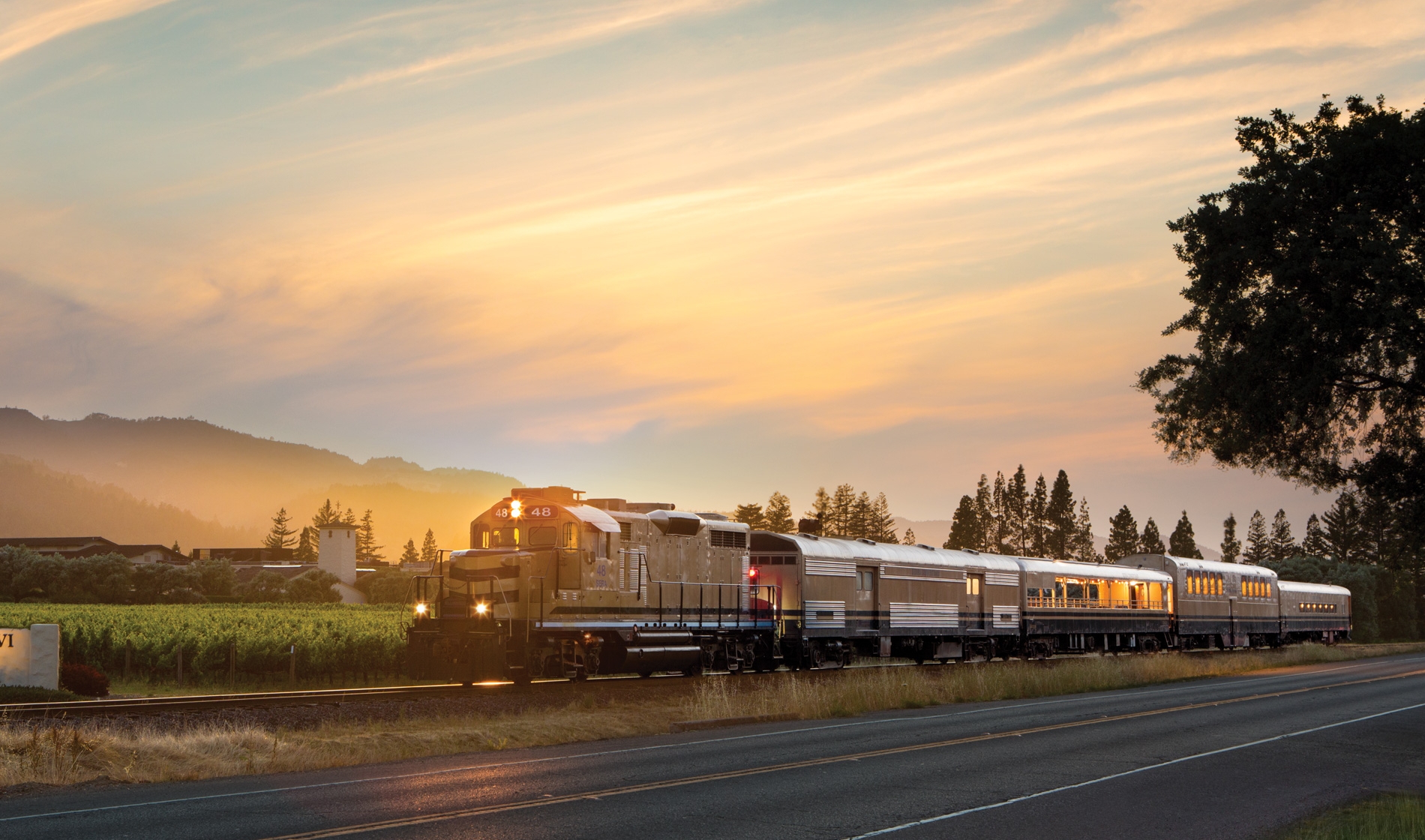Riding the Rails
America’s love affair with train travel continues to chug along.
A train's whistle wails in the distance — a distinctive tone that propagates for miles, ricocheting off of rocky hillsides and lingering on the soft breezes. From the clattering locomotives of yesteryear to the sleek luxury trains of today, train travel’s evolutionary journey mirrors the ebbs and flows of progress and the ever-changing preferences of discerning passengers.
IN THE BEGINNING
In 1804, after a series of rail and engine advancements, British engineer Richard Trevithick built the first full-size steam-powered locomotive to run on rails, pulling a series of cars loaded with 10 tons of iron and 70 people, but it was purely a proof-of-concept demonstration. There were lots of problems to be solved before trains would become a primary mode of transportation.
Progress chugged forward and by 1830, the first commercial passenger railway opened in England. Rail transportation became a reality in North America in 1830 with the opening of the 13-mile Baltimore and Ohio Railroad. By mid century, more than 9,000 miles of tracks crisscrossed the American landscapes east of Missouri, like veins breathing life into the country, and suddenly, places that once seemed impossibly remote became accessible. Trains moved everything from mail, timber, agricultural products and minerals to people, but in an era before sleeping and dining cars were introduced (George Pullman’s first sleeping car rolled onto the scene in 1865, followed by “hotel cars”), long distance travel by rail was far from a luxurious experience.
The transcontinental railroad project was considered one of the greatest American technological feats of the 19th century, built at the same time that America battled itself in the Civil War. The tracks of the Union Pacific Railroad met the tracks of the Central Pacific Railroad at Promontory Summit, Utah Territory in 1869, and in front of a small crowd, Leland Stanford hammered in the “Golden Spike” which connected the East with the West for both personal travel and commerce.

The Grand Canyon Railway has delighted train passengers since 1901. Photos courtesy of the railroads; Grand Canyon Railway: Xanterra Travel Collection
In 1870, it took about 102 hours and $134.50 to travel first class in a Pullman sleeping car through prairies, mountains and deserts from Omaha, Nebraska, to San Francisco. Second-class travelers paid $110 per ticket, and third class paid $65.
For nearly half a century, a period known as the Golden Age of Railroading, no other mode of transportation challenged train travel, as the network of tracks grew from 35,000 to 254,000 miles. Powerful diesel-electric locomotives entered service a few years after WWI ended, ushering in more improvements and capabilities.
In 1920, over a million Americans rode the rails from one location to another, but travelers soon became more enamored with automobiles, buses and planes. Seemingly overnight, the nation lost interest in building more rails. Opting instead to construct elaborate networks of highways, Americans began dreaming of owning their own vehicles and hitting the road.
Many believed passenger trains had come and gone, but they were wrong. Luxury train travel that first emerged in the late 19th century as a lavish mode of transportation continues to captivate adventure seekers the world over to today. Pioneered by trains like the luxurious Orient Express, these opulent carriages combine unparalleled comfort, gourmet dining, premium service, extravagant amenities and spectacular views. Passengers on luxury trains are treated to almost effortless journeys while enjoying both urban environments and rolling, lush landscapes. Indeed, Agatha Christie wrote that “To travel by train is to see nature and human beings, towns and churches and rivers — in fact, to see life.”
ALL ABOARD!
Today, there are several luxury trains rolling the rails across North America — all with different destinations and points of interest.
The Rocky Mountaineer offers four exceptional train journeys. First, Passage to the West takes passengers from Vancouver to Lake Louise or Banff as it traverses through the towering Rockies and untouched wilderness. Two different routes — Journey through the Clouds and Rainforest to Gold Rush — take passengers from Vancouver to Jasper National Park as they enjoy endless natural wonders. And, lastly, the Rockies to the Red Rocks line glides past stunning red rock formations in Moab, Utah, crossing the Continental Divide, and enjoying vista views en route to Denver. Travel takes place during the day to take advantage of the sightseeing, and travelers can choose which destination to start in, as trains run both ways. Aside from taking in the mesmerizing panoramic views from elegant glass-dome cars, hosts share stories of the region’s history as passengers devour delicious, three-course plated meals that complement the picturesque views.
The Napa Valley Wine Train travels along a 36-mile round trip route to St. Helena and back, showcasing the scenic beauty of the Napa Valley and stopping at a few celebrated wineries along the journey for exclusive insider tours. Passengers dine on divine four-course meals paired with local wines in restored vintage Pullman cars showcasing Honduran mahogany paneling, brass accents, etched glass partitions and plush armchairs — a rolling museum of early American train travel.
Since 1901, the Grand Canyon Railway has transported passengers from Williams, Arizona, to the south rim of one of the world’s most magnificent natural wonders. Today, passengers board restored vintage rail cars in the morning light and roll into the Grand Canyon Depot before high noon. Day travelers who prefer an elegant rail experience can book the Luxury Parlor Class or Luxury Dome Class cars and raise a glass to the many influential people who rode these rails through its celebrated history — folks such as Theodore Roosevelt, John Muir, Franklin Delano Roosevelt, Dwight Eisenhower, Clark Gable and Doris Day.
WORLD-CLASS WANDERLUST

The Simplon-Orient-Express features routes through Europe’s greatest cities. Photos courtesy of the railroads; Grand Canyon Railway: Xanterra Travel Collection
Overseas, luxury train travel captivates travelers with its opulence and charm in countries around the globe. The Venice Simplon-Orient-Express, A Belmond Train, is a work of art in itself. Lovingly restored to reflect its 1920s glory days, it features rich wood marquetry panels, Art Deco designs and marble en-suite bathrooms.
The train glides into some of the most alluring cities in Europe — Paris, Budapest, Venice, Amsterdam and beyond. Passengers rave about the full butler service, the free-flowing Champagne, the craft cocktails and the lounge car pianist who plays songs on request until guests feel like falling into their pillows.
For those who want to explore the land Down Under in style, The Ghan (shortened from “The Afghan Express”) celebrates over 90 years of history, harkening back to the 1930s, when the first Afghan cameleers arrived in Australia. Today, travelers are rewarded with a north-south cross-country journey covering 1,850 miles. Spectacular and diverse landscapes range from the pastoral hues of the South Australian plains to the rusty reds of the MacDonnell Ranges and the tropical greens of Katherine and Darwin. Passengers enjoy the views from the comfort of spacious, sophisticated cabins with expansive windows for taking in the beauty of the Outback.

The Rocky Mountaineer offers journeys through the Rocky Mountains of Canada and the United States. Photos courtesy of the railroads; Grand Canyon Railway: Xanterra Travel Collection
India’s Maharajas’ Express also tops the global list of rail travel must-dos with four multi-day journeys. Focal points include stops at the Taj Mahal in Agra and afternoons at Ranthambore National Park, a wildlife sanctuary famous for seeing India’s majestic tigers. The Maharajas’ Express immerses its travelers in ancient culture with lavishly decorated cabins, where guests enjoy cocktails, books, board games and international cuisine beneath hand-painted ceilings.
Train travel leaves an indelible imprint on those who choose to ride the rails. Today’s luxury trains blend opulence, nostalgia and adventure into a truly unforgettable experience.
AMERICA’S HIGHEST RAILWAY
The Broadmoor Manitou and Pikes Peak Cog Railway in Manitou Springs, Colorado, is the world’s highest and longest cog railroad — especially designed to climb steep mountains. The 3-hour round trip takes guests to the top of 14,115-feet-high Pikes Peak — a journey many describe as the “gateway to heaven.” There are only two cog railways in the United States. The “cog” refers to a toothed central rail between the outer bearing rails that engages with a cogwheel located underneath the locomotive, providing superior traction.
The Broadmoor Manitou and Pikes Peak Cog Railway’s history began in 1891, when a ticket cost $5, a considerable fare for a passenger at the time. In 2021, just in time for its 130th birthday, the railway reopened after a $100-million renovation that offers visitors new trains, a new depot and Summit Visitor Center, and a new track.
The Broadmoor Manitou and Pikes Peak Cog Railway charms its many guests as it passes boulder-strewn canyons, waterfalls, pristine forests, historic sites and abundant wildlife including elk, deer, bighorn sheep and yellow-bellied marmots. After the 9-mile ascent, adventure seekers enjoy time to take in the views of the Collegiate and Sangre de Cristo mountain ranges, the Continental Divide, the mining town of Cripple Creek and more.
To take greater advantage of the amazing views, The Broadmoor Manitou and Pikes Peak Cog Railway began offering sunrise voyages in 2023. As guests watch the sunrise from the breathtaking Rocky Mountains, it’s easy to see why Katharine Lee Bates was inspired to write “America the Beautiful” after a trip to the area in 1893. To learn more, visit cograilway.com.




